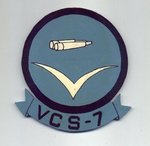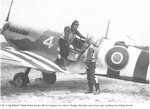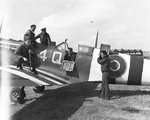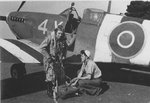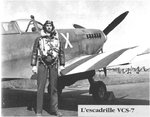Navigation
Install the app
How to install the app on iOS
Follow along with the video below to see how to install our site as a web app on your home screen.
Note: This feature may not be available in some browsers.
More options
You are using an out of date browser. It may not display this or other websites correctly.
You should upgrade or use an alternative browser.
You should upgrade or use an alternative browser.
USN VCS-7 Spitfire Mk Vb
- Thread starter DBII
- Start date
Ad: This forum contains affiliate links to products on Amazon and eBay. More information in Terms and rules
More options
Who Replied?- Thread starter
- #2
DBII
Senior Master Sergeant
For a short story of VCS-7 see page 3, VCS-8 see page 4, and VOF-1 page 5. VOF-1 was Hellcats used in France as spotter planes.
http://www.history.navy.mil/download/ww2-30.pdf
DBII
http://www.history.navy.mil/download/ww2-30.pdf
DBII
- Thread starter
- #3
DBII
Senior Master Sergeant
This article was first published in Naval Aviation News, May-June 1994
VCS-7, Seagulls to Spitfires
Naval Aviation's mission on 6 June was to provide air spotting support for the cruisers and battleships bombarding targets along the Normandy beachhead. For this purpose, each vessel normally carried several aviators and two or three floatplanes, either SOC Seagulls or OS2U Kingfishers. Both aircraft performed the spotting mission quite well. Operations in the Mediterranean during 1943 had shown, however, that against strong enemy aerial opposition the SOCs and OS2Us were far too vulnerable. They lacked the speed and manoeuvrability to escape attacks made by Focke-Wulf Fw 190s and Messerschmitt Bf 109s. In the Mediterranean, efforts were being made to train VCS pilots in the handling of fighters such as the P-40 Warhawk and P-51 Mustang. Flying fighters, the air spotting pilots stood a much better chance of eluding enemy air attacks.
Perhaps because of the high demand on P-51s for strategic bomber escort duties, it was decided that 17 VCS and Battleship Observation (VO) pilots aboard the cruisers Quincy (CA 71) Tuscaloosa (CA 37) and Augusta (CA 31) and the battleships Nevada (BB 36) Arkansas (BB 33) and Texas (BB 35) would be checked out in RAF Spitfire Mk Vbs. The 67th Tactical Reconnaissance Group, Ninth Air Force, under the command of Colonel George W. Peck, was assigned the task of checking out the VCS-7 aviators in Spitfires. Training was conducted at the 67th's base in Middle Wallop, Hampshire. The training syllabus consisted of defensive fighter tactics, aerobatics, navigation, formation flying and spotting procedures.
On 8 May, Lieutenant Robert W. Calland, senior aviator aboard Nevada, assumed command of the squadron. He was relieved by Lieutenant Commander William Denton, Jr., senior aviator aboard Quincy, on the 28th. That same day, the squadron became fully operational and moved to Royal Naval Air Station (RNAS) Lee-on-Solent. Ten squadrons, five RAF, four Royal Navy FAA (Fleet Air Arm) and VCS-7, were brought together at Lee-on-Solent to provide air spotting for the fire support ships of the Western and Eastern Naval Task Forces. The Western Naval Task Force, Rear Admiral Alan G. Kirk commanding, would land the US. First Army on beaches Utah and Omaha. The Eastern Naval Task Force would land the British Second Army on beaches Gold, Juno and Sword. Two of the RAF squadrons, Nos. 26 and 63, flew Spitfires. The other three, Nos. 2, 268 and 414, flew Mustang Mk. Is and Mk. lAs. The four FAA squadrons, Nos. 808, 897, 885 and 886, were assigned Seafire Mk. Ills.
On D-day, all aircraft were pooled. This meant that VCS-7 flew whatever type was available, either Seafire or Spitfire. Although Mustangs were present, they were not flown by any VCS-7 aviators-the reason being that they had not been checked out in the type. At noon on D-Day, the RAF Mustangs were withdrawn for tactical reconnaissance duties. This left some 95 aircraft available for air spotting support at RNAS Lee-on-Solent.
Typical spotting missions utilized two aircraft. The lead plane functioned as the spotter. The wingman, or "weaver", provided escort and protected the flight against enemy aerial attack. The clocking, or ship control, method was utilized on the majority of spotting sorties. Standard altitude for spotting missions was 6,000 feet, but poor weather forced the spotter to operate between 1,500 and 2,000 feet. Occasionally, missions were flown at even lower altitudes. Drop tanks were used to increase range. A typical spotting sortie lasted close to two hours. This provided 45 minutes on station and 1 hour in transit.
The Luftwaffe was rarely encountered, although six of the station's aircraft were shot down by German fighters. Four VCS-7 pilots were attacked by Bf 109s and Fw 190s, putting the fine defensive capabilities of the Spitfire to the test. All four aviators successfully avoided being shot down. Flak, however, was common and accounted for the squadron's only loss, Lieutenant Richard M. Barclay, senior aviator aboard Tuscaloosa. Lt. Barclay's wingman, Lieutenant (jg) Charles S. Zinn, also from Tuscaloosa, managed to return home despite severe damage to his right wing and aileron.
The exact number of aircraft lost by VCS-7 during the Normandy campaign cannot be verified as of this writing. VCS-7's action report mentions only the loss of Lt. Barclay's aircraft. Author David Brown in his book, The Seafire, the Spitfire that went to sea, claims that VCS-7 lost 7 aircraft to enemy action and 1 operationally in 209 sorties flown. Unfortunately, Mr. Brown fails to cite the source of his information. According to VCS7's action report, the squadron flew a total of 191 sorties between 6 and 25 June. The busiest days were the 6th, 7th and 8th. During those three days, a total of 94 sorties were flown.
Following the bombardment of Cherbourg on 26 June, naval gunfire support operations ceased. The fighting had moved inland out of the range of the ships big guns. VCS-7 was, therefore, disbanded by order of Adm. Kirk, and all personnel returned to their ships.
During 20 days of combat operations, the aviators of VCS-7 were awarded 9 Distinguished Flying Crosses, 6 Air Medals and 5 Gold Stars in lieu of additional Air Medals. Ten VCS-7 aviators went on to participate in the invasion of southern France and three others took part in the invasions of Iwo Jima and Okinawa in the Pacific during 1945.
Naval Gunfire Spotting
During the course of the three days of the invasion, VCS-7 alone flew a total of 94 sorties and 191 between 6 Jun and 25 Jun. Once Cherbourg fell VCS-7 was disbanded and the Spitfires were returned to the British.
Postscript. A VCS-7 pilot, ENS Adams, was the first Naval Aviator to land in France when he landed his damaged Spitfire at an auxiliary landing field in France.
LEE-ON-SOLENT VCS-7 U S Navy From D-Day, June 6, 1944 until June 26, when the American naval bombardment was terminated, US Naval Spitfires based at Lee-on-Solent flew 209 missions in support of the Allied invasion. VCS-7 operated primarily with the Western Naval Task Force, which was mainly drawn from the US Navy Nine aircraft were lost to all causes although there was apparently only one pilot,Lt R M Barclay, lost due to enemy action. There is some disagreement by various sources about the actual casualties. US aircraft damage losses were higher percentage wise than RAF/RN-presumably due to the USN pilots relative lack of type experience.
The Squadron flew 191 operational sorties between 6 and 25th June. The last naval bombardment (of Cherbourg) took place on the 26th June, following which the squadron was disbanded and personnel returned to their ships.
Ens Adams is no longer with us but I have his daughter's email address from a VSC webite. I will send her a note to see if she has any stores/photos to share.
DBII
VCS-7, Seagulls to Spitfires
Naval Aviation's mission on 6 June was to provide air spotting support for the cruisers and battleships bombarding targets along the Normandy beachhead. For this purpose, each vessel normally carried several aviators and two or three floatplanes, either SOC Seagulls or OS2U Kingfishers. Both aircraft performed the spotting mission quite well. Operations in the Mediterranean during 1943 had shown, however, that against strong enemy aerial opposition the SOCs and OS2Us were far too vulnerable. They lacked the speed and manoeuvrability to escape attacks made by Focke-Wulf Fw 190s and Messerschmitt Bf 109s. In the Mediterranean, efforts were being made to train VCS pilots in the handling of fighters such as the P-40 Warhawk and P-51 Mustang. Flying fighters, the air spotting pilots stood a much better chance of eluding enemy air attacks.
Perhaps because of the high demand on P-51s for strategic bomber escort duties, it was decided that 17 VCS and Battleship Observation (VO) pilots aboard the cruisers Quincy (CA 71) Tuscaloosa (CA 37) and Augusta (CA 31) and the battleships Nevada (BB 36) Arkansas (BB 33) and Texas (BB 35) would be checked out in RAF Spitfire Mk Vbs. The 67th Tactical Reconnaissance Group, Ninth Air Force, under the command of Colonel George W. Peck, was assigned the task of checking out the VCS-7 aviators in Spitfires. Training was conducted at the 67th's base in Middle Wallop, Hampshire. The training syllabus consisted of defensive fighter tactics, aerobatics, navigation, formation flying and spotting procedures.
On 8 May, Lieutenant Robert W. Calland, senior aviator aboard Nevada, assumed command of the squadron. He was relieved by Lieutenant Commander William Denton, Jr., senior aviator aboard Quincy, on the 28th. That same day, the squadron became fully operational and moved to Royal Naval Air Station (RNAS) Lee-on-Solent. Ten squadrons, five RAF, four Royal Navy FAA (Fleet Air Arm) and VCS-7, were brought together at Lee-on-Solent to provide air spotting for the fire support ships of the Western and Eastern Naval Task Forces. The Western Naval Task Force, Rear Admiral Alan G. Kirk commanding, would land the US. First Army on beaches Utah and Omaha. The Eastern Naval Task Force would land the British Second Army on beaches Gold, Juno and Sword. Two of the RAF squadrons, Nos. 26 and 63, flew Spitfires. The other three, Nos. 2, 268 and 414, flew Mustang Mk. Is and Mk. lAs. The four FAA squadrons, Nos. 808, 897, 885 and 886, were assigned Seafire Mk. Ills.
On D-day, all aircraft were pooled. This meant that VCS-7 flew whatever type was available, either Seafire or Spitfire. Although Mustangs were present, they were not flown by any VCS-7 aviators-the reason being that they had not been checked out in the type. At noon on D-Day, the RAF Mustangs were withdrawn for tactical reconnaissance duties. This left some 95 aircraft available for air spotting support at RNAS Lee-on-Solent.
Typical spotting missions utilized two aircraft. The lead plane functioned as the spotter. The wingman, or "weaver", provided escort and protected the flight against enemy aerial attack. The clocking, or ship control, method was utilized on the majority of spotting sorties. Standard altitude for spotting missions was 6,000 feet, but poor weather forced the spotter to operate between 1,500 and 2,000 feet. Occasionally, missions were flown at even lower altitudes. Drop tanks were used to increase range. A typical spotting sortie lasted close to two hours. This provided 45 minutes on station and 1 hour in transit.
The Luftwaffe was rarely encountered, although six of the station's aircraft were shot down by German fighters. Four VCS-7 pilots were attacked by Bf 109s and Fw 190s, putting the fine defensive capabilities of the Spitfire to the test. All four aviators successfully avoided being shot down. Flak, however, was common and accounted for the squadron's only loss, Lieutenant Richard M. Barclay, senior aviator aboard Tuscaloosa. Lt. Barclay's wingman, Lieutenant (jg) Charles S. Zinn, also from Tuscaloosa, managed to return home despite severe damage to his right wing and aileron.
The exact number of aircraft lost by VCS-7 during the Normandy campaign cannot be verified as of this writing. VCS-7's action report mentions only the loss of Lt. Barclay's aircraft. Author David Brown in his book, The Seafire, the Spitfire that went to sea, claims that VCS-7 lost 7 aircraft to enemy action and 1 operationally in 209 sorties flown. Unfortunately, Mr. Brown fails to cite the source of his information. According to VCS7's action report, the squadron flew a total of 191 sorties between 6 and 25 June. The busiest days were the 6th, 7th and 8th. During those three days, a total of 94 sorties were flown.
Following the bombardment of Cherbourg on 26 June, naval gunfire support operations ceased. The fighting had moved inland out of the range of the ships big guns. VCS-7 was, therefore, disbanded by order of Adm. Kirk, and all personnel returned to their ships.
During 20 days of combat operations, the aviators of VCS-7 were awarded 9 Distinguished Flying Crosses, 6 Air Medals and 5 Gold Stars in lieu of additional Air Medals. Ten VCS-7 aviators went on to participate in the invasion of southern France and three others took part in the invasions of Iwo Jima and Okinawa in the Pacific during 1945.
Naval Gunfire Spotting
During the course of the three days of the invasion, VCS-7 alone flew a total of 94 sorties and 191 between 6 Jun and 25 Jun. Once Cherbourg fell VCS-7 was disbanded and the Spitfires were returned to the British.
Postscript. A VCS-7 pilot, ENS Adams, was the first Naval Aviator to land in France when he landed his damaged Spitfire at an auxiliary landing field in France.
LEE-ON-SOLENT VCS-7 U S Navy From D-Day, June 6, 1944 until June 26, when the American naval bombardment was terminated, US Naval Spitfires based at Lee-on-Solent flew 209 missions in support of the Allied invasion. VCS-7 operated primarily with the Western Naval Task Force, which was mainly drawn from the US Navy Nine aircraft were lost to all causes although there was apparently only one pilot,Lt R M Barclay, lost due to enemy action. There is some disagreement by various sources about the actual casualties. US aircraft damage losses were higher percentage wise than RAF/RN-presumably due to the USN pilots relative lack of type experience.
The Squadron flew 191 operational sorties between 6 and 25th June. The last naval bombardment (of Cherbourg) took place on the 26th June, following which the squadron was disbanded and personnel returned to their ships.
Ens Adams is no longer with us but I have his daughter's email address from a VSC webite. I will send her a note to see if she has any stores/photos to share.
DBII
Airframes
Benevolens Magister
Nice choice DB. Somewhere I have a similar article from, I think, Fly Past magazine, with some pics of the aircraft. They're probably the same pics as you might already have, but let me know if they're of interest.
B-17engineer
Colonel
Very cool DB
- Thread starter
- #6
DBII
Senior Master Sergeant
Sure Terry, always like to see more pictures. The planes are basic Spitfire, no special camo like photo recon blue. The stripes were painted over the unit markings on the tail and new markings were paint in white just a head of the cockpit. The planes were ocean grey and dark green and dark ocean grey and dark green. Here is the last bit of research I will pass along for now. I found the Action Report for BB-35. I typed up the section about VCS-7.
From the Action Report BB-35, USS Texas, June 6 144
Spotting by the Spitfire pilots was generally excellent and their often amusing comments were much enjoyed. They showed great keenness and efficiency in location targets of opportunity although the zeal of one pilot nearly proved fatal. His strafing of an enemy staff car cost him some flak damage to his plane and necessitated his quick return to his home base.
Of the 19 main gun fire missions, 17 were controlled by VCS-7. Below are the first ten fire missions of the 14 inch gunss:
Target, Rounds , Results
155 mm guns @ Point Du Hoc, 255 rounds, neutralized
Fortified position, 17 rounds, fire effective
Strong Point, MG and pill boxes, 11 rounds, direct hit
Fortified position, 4x 155 mm mortars, 26 rounds, several direct hits
Mobile field battery, 40 rounds, fire effective
Gun position is woods, 26 rounds, guns silenced
Troop transports, flak station, powerhouse, ammo dump, 18 rounds, direct hit ammo dump powerhouse
Troops at crossroads, 24 rounds, dispersed troops
Enemy vehicles, 18 rounds, fire effective several hits
Troops and vehicles, 10 rounds, fire effective, many hits and several fires
DBII
From the Action Report BB-35, USS Texas, June 6 144
Spotting by the Spitfire pilots was generally excellent and their often amusing comments were much enjoyed. They showed great keenness and efficiency in location targets of opportunity although the zeal of one pilot nearly proved fatal. His strafing of an enemy staff car cost him some flak damage to his plane and necessitated his quick return to his home base.
Of the 19 main gun fire missions, 17 were controlled by VCS-7. Below are the first ten fire missions of the 14 inch gunss:
Target, Rounds , Results
155 mm guns @ Point Du Hoc, 255 rounds, neutralized
Fortified position, 17 rounds, fire effective
Strong Point, MG and pill boxes, 11 rounds, direct hit
Fortified position, 4x 155 mm mortars, 26 rounds, several direct hits
Mobile field battery, 40 rounds, fire effective
Gun position is woods, 26 rounds, guns silenced
Troop transports, flak station, powerhouse, ammo dump, 18 rounds, direct hit ammo dump powerhouse
Troops at crossroads, 24 rounds, dispersed troops
Enemy vehicles, 18 rounds, fire effective several hits
Troops and vehicles, 10 rounds, fire effective, many hits and several fires
DBII
Last edited:
Heinz
Captain
Great choice DB! 
dirkpitt289
Master Sergeant
Sounds good DB
Crimea_River
Marshal
Looking forward to this one!
ozhawk40
Master Sergeant
Great choice DBII and good research. 8)
Cheers
Peter
Cheers
Peter
Cool !! DB
kgambit
Tech Sergeant
Goof choice DB. 
109ROAMING
2nd Lieutenant
Sweet build
Vic Balshaw
Major General
Great selection DB and very good background information on a little known aspect of the 'D' day landings.




vikingBerserker
Lieutenant General
Nice!
- Thread starter
- #17
DBII
Senior Master Sergeant
I finaly found some light sea gray over the weekend. I have never used TAMIYA brand before. It looks to dark. Can anyone direct me to the thread that has the color chips?
DBII
DBII
B-17engineer
Colonel
VCS-7...is what they were listed as...The first picture is in question...
one picture is big I know.
Hell, I don't know if any are yours. I can't find the emblem on any of them
one picture is big I know.
Hell, I don't know if any are yours. I can't find the emblem on any of them
Attachments
Last edited:
Airframes
Benevolens Magister
Good work H ! Those are the same pics I've been looking for, without success! (must tidy the piles of magazines in my house!)
They've reminded me of two things.
1) Some of the Spits had six-stack exhausts - beware! 'Normal' Spit V's, and the kits, have three stack exhausts.
2) The kill marking shown on '4Q' was not gained by the unit, it was a left over from previous RAF use.
They've reminded me of two things.
1) Some of the Spits had six-stack exhausts - beware! 'Normal' Spit V's, and the kits, have three stack exhausts.
2) The kill marking shown on '4Q' was not gained by the unit, it was a left over from previous RAF use.
B-17engineer
Colonel
Thanks T 
Users who are viewing this thread
Total: 1 (members: 0, guests: 1)

